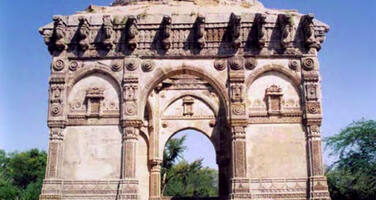Champaner-Pavagadh Archaeological Park
Factors affecting the property in 2005*
- Management systems/ management plan
International Assistance: requests for the property until 2005
Total amount approved : 0 USD
Missions to the property until 2005**
Conservation issues presented to the World Heritage Committee in 2005
At the time of the examination of the Nomination File for the inscription of Champaner on the World Heritage List, in 2004, ICOMOS had recommended that the nomination be deferred to allow the State Party to provide a proper Management Plan and comprehensive planning which would integrate management of the 39 individual components of the property managed by the Archaeological Survey of India, and which would clarify a statement of Outstanding Universal Value to be applied to the entire property. Although the Committee eventually inscribed the property on the basis of information provided by the State Party, it also requested the State Party to monitor the implementation of the Management Plan study already carried out.
The World Heritage Centre received a report from the State Party on 29 January 2005 on the operational status of management mechanisms, referring to various actions taken for the improvement of information and resource management, community awareness-raising and visitor management. The actions include: the initiation of the digital documentation of protected monuments; the establishment of a work-plan for the regular maintenance of the property, comprising removal of encroaching vegetation and re-patching of masonry; the holding of celebrations on the occasion of the “World Heritage Week”, involving students and local community; and the execution of facilities for visitors such as toilets, access ramps for the handicapped and the recruitment of tourist guides. During a national seminar on management of World Heritage Cultural properties, held in New Delhi on 27 and 28 January 2005, the State Government of Gujarat (i.e. the Institution responsible for managing the area), informed the participants that it was going to “provide proper access to the Kalika Mandir on the top of the hill, and provide … the infrastructure for large numbers of religious pilgrims visiting the site”. The report mentioned also the decision of the State Party to set up a Task Force to meet under the Chairmanship of the Chief Secretary of the Government of Gujarat in order to review the progress made in Champaner.
Although the efforts made by the State Party to improve the conservation of the property are highly commendable, an integrated and functioning management framework for the property, built around the Statement of Outstanding Universal value recognized at the time of inscription, does not appear to be yet in place. In the current condition, the property will continue to suffer from ad hoc decisions which might have a negative impact on the heritage values of the property.
ICOMOS suggests that, building on the Management Plan study already carried out, efforts should be directed towards the establishment of a site management entity with full management authority for decision-making on property, answerable to the Archaeological Survey of India, and provided with all the necessary financial support and expertise.
Summary of the interventions
Decisions adopted by the Committee in 2005
29 COM 7B.51
Champaner-Pavagadh Archaeological Park (India)
The World Heritage Committee,
1. Having examined Document WHC-05/29.COM/7B.Rev,
2. Recalling its Decision 28 COM 14B.26, adopted at its 28th session (Suzhou, 2004),
3. Commends the State Party of India for the positive initiatives taken to strengthen the conservation of the property since its inscription on the World Heritage List in 2004;
4. Requests the State Party to establish the following:
a) a site-management entity with full management authority for decisionmaking on property, answerable to the Archaeological Survey of India, and provided with all the necessary financial support and expertise; and
b) a management plan developed with full involvement of the established management authority, and built around the Statement of outstanding universal value, to ensure the integrated conservation of the property.
5. Requests the State Party to submit a report on the progress achieved in the implementation of the above-recommendations to the World Heritage Centre by 1 February 2007, for examination by the Committee at its 31st Session (2007).
Draft Decision: 29 COM 7B.51
The World Heritage Committee,
1. Having examined Document WHC-05/29.COM/7B.Rev ,
2. Recalling its Decision 28 COM 14B.26, adopted at its 28th session (Suzhou, 2004),
3. Commends the State Party for the positive initiatives taken to strengthen the conservation of the property since its inscription on the World Heritage List in 2004;
4. Expresses its concern about the continuing lack of an integrated and functioning management framework for the conservation of this property,
5. Requests the State Party to establish the following:
a) A site-management entity with full management authority for decision-making on property, answerable to the Archaeological Survey of India, and provided with all the necessary financial support and expertise;
b) A Management Plan developed with full involvement of the established management authority, and built around the statement of Outstanding Universal Value, to ensure the integrated conservation of the property.
6. Requests the State Party to submit a report on the progress achieved in the implementation of the above-recommendations to the World Heritage Centre by 1 February 2007, for examination by the Committee at its 31st Session in 2007.
Exports
* :
The threats indicated are listed in alphabetical order; their order does not constitute a classification according to the importance of their impact on the property.
Furthermore, they are presented irrespective of the type of threat faced by the property, i.e. with specific and proven imminent danger (“ascertained danger”) or with threats which could have deleterious effects on the property’s Outstanding Universal Value (“potential danger”).
** : All mission reports are not always available electronically.


